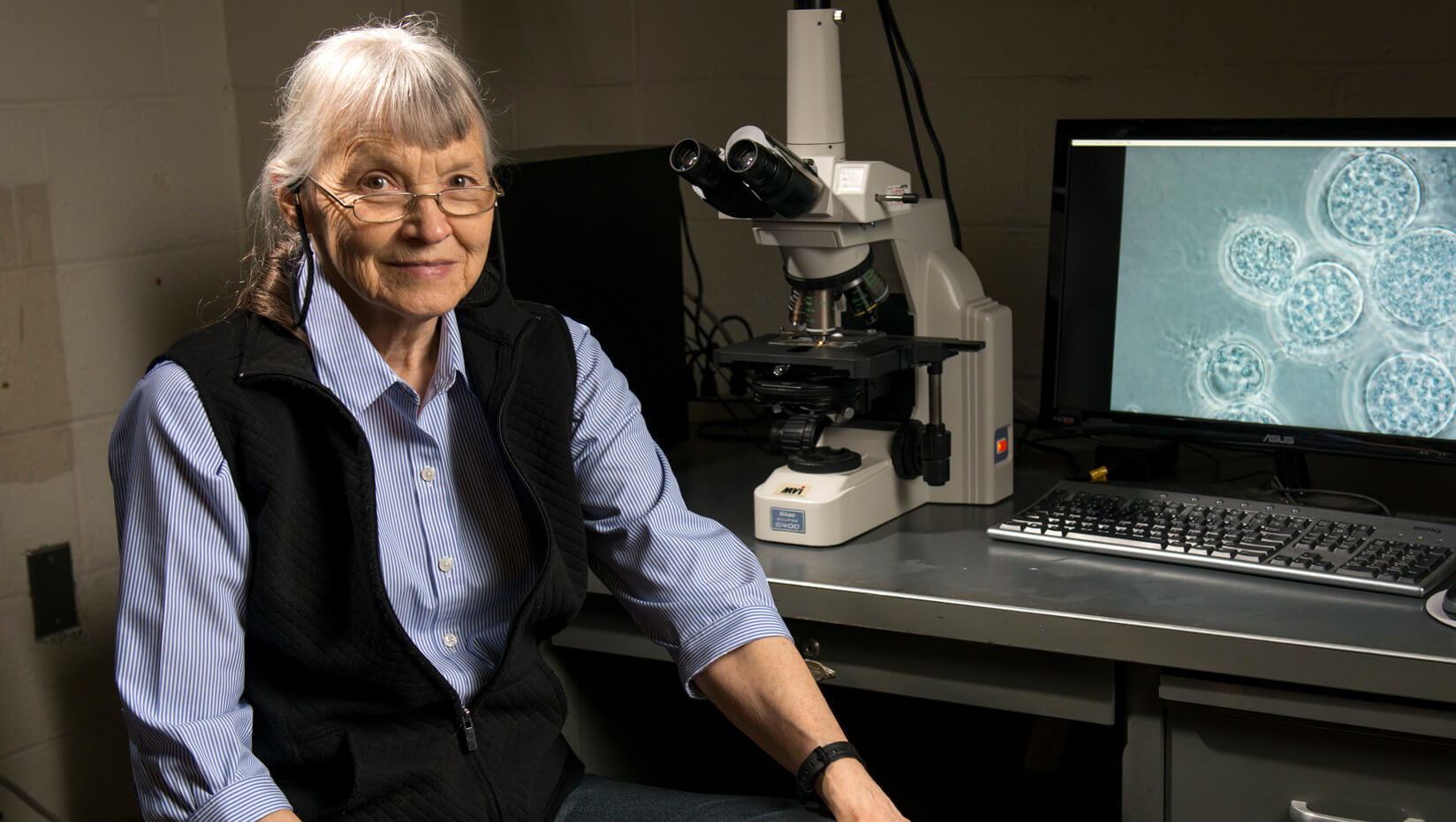
Longcore receives AAAS Golden Goose Award for impactful research
Editor’s note: Story updated Sept. 28.
On Oct. 13, 1997, Joyce Longcore picked up a flask of fluid sitting on the table next to her microscope. The flask was full of a mysterious type of a microscopic fungus from a group called Chytridiomycota (chytrids). This particular fungus, extracted from the skin of a dead frog, was sent to her by pathologists at the Smithsonian’s National Zoo in Washington, D.C.
Something was causing a die-off of the zoo’s blue poison dart frogs and this mysterious fungus was the prime suspect.
Days before, she had all but given up on the sample sitting on her table — the organisms she was attempting to isolate into pure culture seemed to refuse to form the zoospores necessary for reproduction. She was convinced the organisms were going to die.
However, on this day — her birthday of all days — something in the glass had changed.
“It [the sample] looked different, it was actually opalescent,” says Longcore, a mycologist and associate research professor at the University of Maine. She suspected that the sample had been contaminated by bacteria, clouding the clear fluid. Perhaps, though, the mysterious little chytrids had begun to grow.
To be sure, she dropped some of the solution on a slide and placed it under the microscope. Zoospores, rhizoids, thalli, and other structures and life stages of the mystery chytrid quickly came into focus. She was looking at what seemed to be the cause of a new disease of amphibians. Until the chytrid that was killing frogs was discovered, no known species of the group was recognized as a pathogen to vertebrates.
“I knew that I had this organism that killed amphibians in pure culture, and that this made research on the disease organism possible,” says Longcore, who, along with her Smithsonian colleagues, is the recipient of a 2017 Golden Goose Award from the American Association for the Advancement of Science (AAAS).
The Golden Goose Award recognizes the people and stories of unexpected and incredible scientific breakthroughs. It highlights federally funded research, which at the surface may seem odd or obscure, but has gone on to make important contributions with serious benefits to society.
In 2012, Longcore was elected as a AAAS Fellow for her groundbreaking chytrid research.
For years her work had flown largely under the radar. Chytrids simply do not garner much attention from anyone, let alone the scientific community. But the discovery of the frog-killing chytrid and its role in the mass die-offs of frog populations worldwide thrust her research into the spotlight.
Longcore and her colleagues from the National Zoo gave the chytrid a scientific name — Batrachochytrium dendrobatidis (Bd). The newly identified chytrid fungus causes chytridiomycosis in amphibians, a disease that was not only killing frogs at the National Zoo, but was ravaging frog populations around the world — from Australia to Central America, and, to date has already driven dozens of species to extinction.
Since the discovery of Bd, Longcore has collected hundreds of different strains of the pathogen from around the world — including Maine. Bd can be found nearly everywhere that amphibians live and it seems to have spread rapidly, largely assisted by human movement and the global trade in amphibians.
Frogs are not the only target of the aquatic fungi. A recently described chytrid species, Batrachochytrium salamandrivorans (Bsal), is similar to Bd with the exception it infects, and kills, salamanders and newts, rather than frogs. Native to East Asia, Bsal arrived in Europe with imported amphibians and was first discovered when researchers began investigating a large decline in Netherland’s fire salamander population.
According to Longcore, the U.S. Southeast is a hotspot for salamander biodiversity and an outbreak of Bsal could be catastrophic.
Longcore’s research didn’t stop with the description of Bd. She has isolated Bd from many places and collaborates with scientists from all over the world by sending them samples for a variety of research purposes, including molecular phylogenics, which, according to Longcore, is the next frontier in understanding the origin and distribution of Bd.
She also consults with algae aquaculturists who are interested in aquatic fungal pathogens that attack their crops.
At her lab at UMaine, hundreds of different types of chytrids, Bd and otherwise, are all cryogenically preserved in liquid nitrogen — her collection has been growing for decades.
“I love a group of organisms and they’re called chytrids,” says Longcore, “much in the same way birdwatchers love birds. They’re beautiful and not a lot of people know what they are.”
“You never know when something that is found will become important. I was content to study a group nobody had much interest in,” says Longcore.
“I still am content to do that work.”
Longcore and her collaborators, Elaine Lamirande, Don Nichols and Allan Pessier, will be honored at the sixth annual Golden Goose Award Ceremony at the Library of Congress in Washington, D.C., Sept. 27.
More information on the 2017 Golden Goose awardees can be found online.
Contact: Walter Beckwith, 207.581.3729
